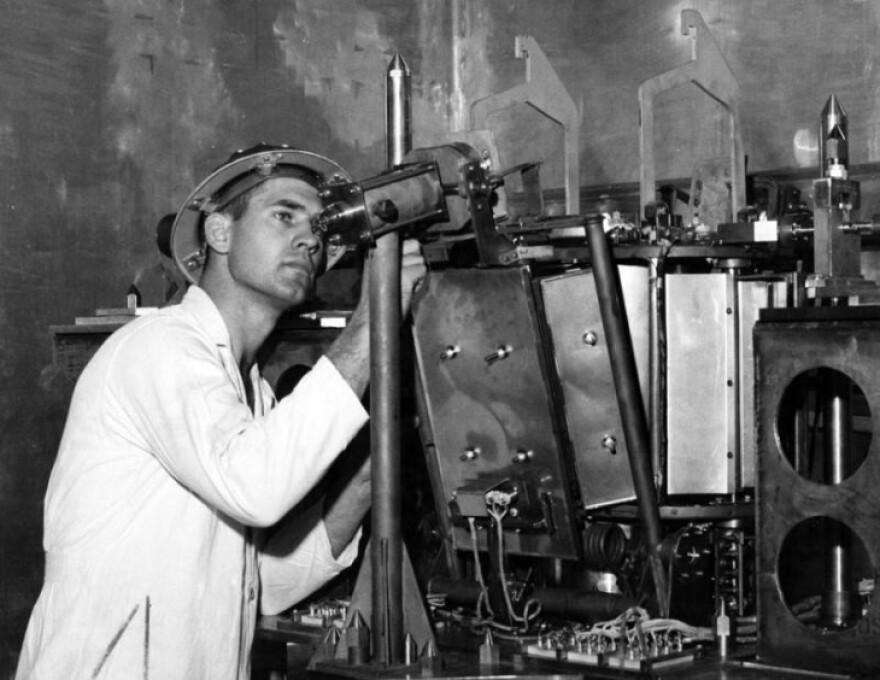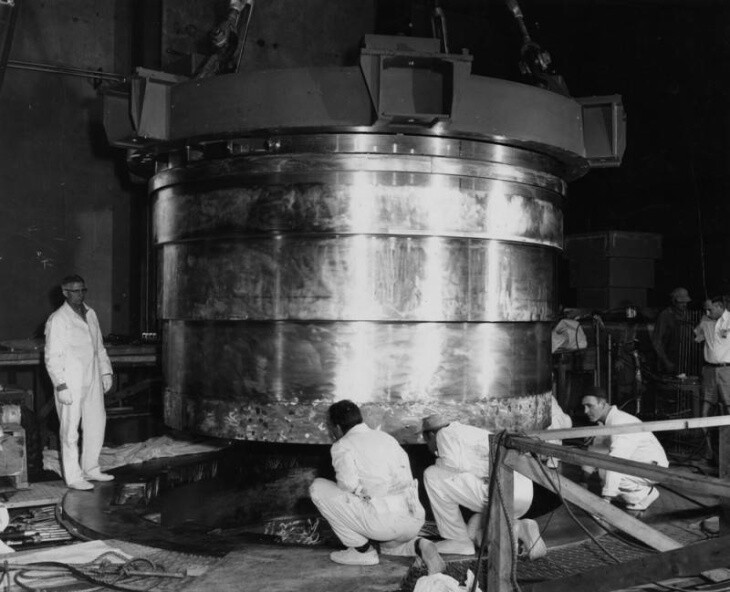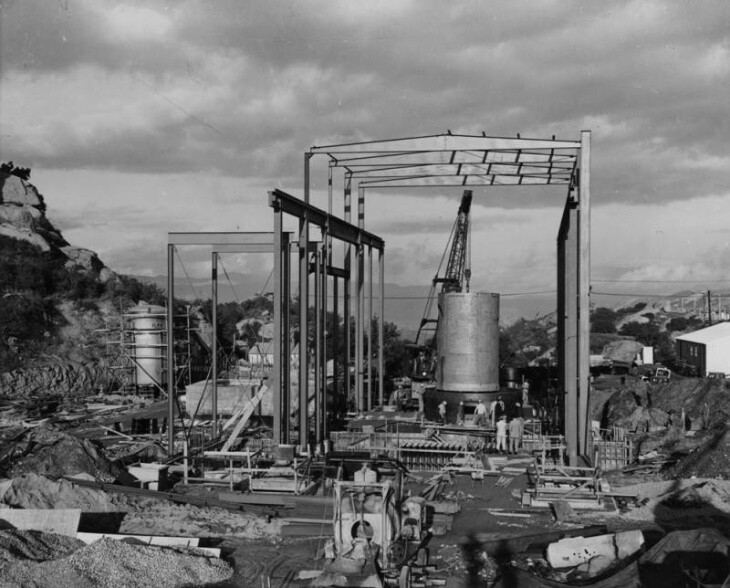Truth matters. Community matters. Your support makes both possible. LAist is one of the few places where news remains independent and free from political and corporate influence. Stand up for truth and for LAist. Make your tax-deductible donation now.
What Happened At The Santa Susana Nuclear Site During The Woolsey Fire?

Additional reporting by Jacob Margolis.
The Woolsey Fire, now one of the largest recorded fires in L.A. County's history, has burned a good portion of the former Santa Susana Field Lab, which was once home to several nuclear reactor and the site of numerous rocket tests. The site is still riddled with radioactive waste and other toxic compounds.
Many of our audience members want to know if there's a risk of those hazardous materials being spread by the fire. You've reached out to ask us...
- "The fire burned the contaminated Santa Susana Field Laboratory, a former nuclear testing site. Who is making sure that air is not toxic?"
- "Did the radioactive waste at #rocketdyne burn and what is the status of chemicals at the facility"
- "Is Santa Susana safe?"
Here's what we know. Public health officials say they found "no evidence of discernible radiation" in areas they tested. Still, experts who have studied the site say there are many unanswered questions.

What Is Santa Susana And Why Should You Care?
The Santa Susana Field Lab was a research facility on a 2,850-acre site in the hills above the San Fernando and Simi valleys. Built in 1947, it was used to test experimental rocket systems and was home to 10 nuclear reactors. In July 1959, one of those reactors suffered a partial meltdown. Workers tried to repair it. When they couldn't, they were ordered to open the reactor's large door, releasing radiation into the air. It likely spread to nearby communities such as Simi Valley, Chatsworth and Canoga Park.
Six weeks after the meltdown, the Atomic Energy Commission issued a statement saying that there had been a minor "fuel element failure" but there had been "no release of radioactive materials" into the environment. That wasn't true.
In 2017, reporter Joel Grover of NBC4, our media partner, documented all of this in "L.A.'s Nuclear Secret," an eight-part series exposing the reactor incident and subsequent cover-up.
NASA and aerospace company Rocketdyne continued to use the Santa Susana facility for thousands of rocket tests through 1990. Those activities also released all sorts of toxic chemicals into the air and deposited them into the groundwater, the surface water and the soil.

What's Up With Santa Susana Now?
Boeing bought most of the site in 1996 and soon closed the Santa Susana Field Laboratory. The company says it's turning the area into an "open space habitat" although the site is still a toxic mess.
A 2012 EPA report didn't paint a pretty picture. Approximately one out of every seven samples contained "concentrations of radioactive materials exceeding background levels." More than 80% of these were man-made radionuclides. This echoed a 1989 Department of Energy report that found there were contaminants in both the soil and the plants.
"The soil, groundwater and surface water that's in the center are all heavily contaminated," says Dan Hirsch, who retired last year as the director of UC Santa Cruz's program on environmental and nuclear policy. He's also the president of Committee to Bridge the Gap, a nonprofit nuclear policy organization.
He says Santa Susana has maybe 100 different toxic chemicals in the soil. They include "a mix of radioactive materials like plutonium, strontium-90 and cesium-137 and a witch's brew of toxic chemicals such as PCBs, dioxins, heavy metals like mercury and chromium-6 and volatile organic compounds like PCE."
According to Cal Fire, the Woolsey Fire started on the afternoon of Thursday, Nov. 8 at E Street and Alfa Road, on the Santa Susana site. Two minutes before the fire was reported, the Chatsworth electric substation, which is also on the Santa Susana site, experienced a disturbance. Whether those two things are connected, we don't know.
What Happens To Radioactive Waste When There's A Fire?
During a fire, there are two primary ways contaminants in the soil can get into the air.
- Plants and brush suck up pollutants from the soil. When vegetation burns, it releases those contaminants into the air.
- Some pollutants also exist in the soil in solid form, as small particles. When the soil heats up, these solids become gases or they vaporize. It's like putting a pot of boiling water on a stove; when the liquid gets hot enough, it turns to steam.
Something like the Woolsey Fire could potentially release substantial amounts of that contamination, according to Hirsch, and those airborne particles will travel as far as the smoke goes. Approximately half a million people live within ten miles of Santa Susana.
Dr. Jonathan Samet, the dean of the Colorado School of Public Health, has a more optimistic outlook. He says, "Yes, some materials would likely have been disseminated. The good news is that anything that might be in the smoke is going to be distributed across a very wide area."
That means it'll be tough to tell if we're going to see higher cancer rates since so many people will have been exposed.

What Do Officials Say About The Risk?
On Friday, Nov. 9, at 1:30 a.m., only 11 hours after the fire began, California's Department of Toxic Substances Control issued a statement that said, in part:
"Our scientists and toxicologists have reviewed information about the fire's location and do not believe the fire has caused any releases of hazardous materials that would pose a risk to people exposed to the smoke."
Tuesday, Nov. 13, at around noon, the DTSC issued an update that said:
"Our staff were able to access the site Saturday morning and assess damage caused by the fire. We confirmed that the SSFL facilities that previously handled radioactive and hazardous materials were not affected by the fire.
Over the weekend our multi-agency team took measurements of radiation and hazardous compounds, both on the site and in the surrounding community. The results from this initial round of testing showed no radiation levels above background levels, and no elevated levels of hazardous compounds other than those normally present after a wildfire."
DTSC officials did not respond to our requests for details about how they reached their conclusions.
We asked DTSC what kind of measurements they took, when and where they took these measurements and what equipment they used. We asked DTSC what data they gathered and if they would share that data.
They haven't answered those questions.
On Tuesday afternoon, we received an email from Russ Edmondson, a spokesperson for the DTSC, that said:
"The update that we sent is the information that we have at this time. We will post another update on our website (under "latest news") when we have more information.
Hirsch has serious doubts about DTSC's methodology and transparency, calling the agency's statements "public relations pablum."
"The [DTSC] has a horrid history of essentially being a captured regulatory agency, captured by the polluters it's supposed to regulate," Hirsch says.
On Tuesday, the L.A. County Department of Public Health said it had conducted its own tests at the request of Supervisor Kathryn Barger and found "no discernible level of radiation in the tested area."
The department said it used radiation detection units, performed nuclide identification and collected air samples. It also said tests performed by several other agencies, including the California National Guard and the Department of Energy, resulted in similar findings.







